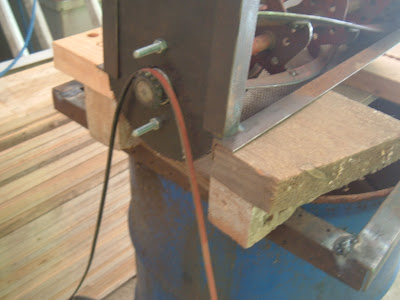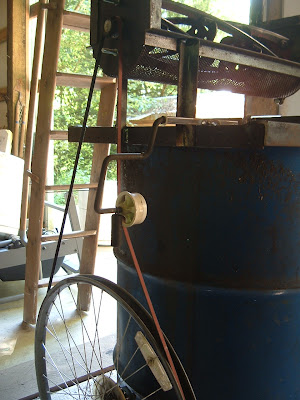Once both ends of the container, lets call it the hopper, had been put together it was time to weld some bracing between them.
I tacked a temporary brace between the two ends, in order to keep it straight and true, and then welded in one of the supports for the top. Then the next.
After that came the two pieces that would hold the grate in place.
The grate, a metal mesh i found, would serve the purpose of filtering the straw. Once the straw was chopped finely enough, it would pass through the grate into a container below. Until then, it would swirl around inside of the container. I was pretty proud of the mesh, frankly. Because i thought it a good idea, but also because there happened to be this one random piece of metal that was rusting away and bent out of shape that i managed to save for the job. It took some pounding with a hammer, some bending, some wirebrushing, but it turned out pretty nice.
The best part was that it fit in the frame perfectly. It fit so well that i didn't even need to weld it into place, its natural tension kept it snugly put. This was a big relief, i was concerned about welding it. Another perk of the tension fit was that it was then removable, making the whole thing easier to clean, access, repair.
At about roughly the time that i was finishing this portion of the machine i undertook a large side project- renovating the shop space. I'll retain the details of that for a later post, save that it took a very long time- maybe a month or two. And somewhere in there Chris, the natural builder who proposed the straw chopper, let me know that the machine was taking too long. The deadline in mind was a natural building workshop, the idea being that the chopper would be used to chop the straw for the workshop. Get it done, i was told. Fast.
I understood the need to finish the project, it was definitely taking too long. Though it was disappointing to let go of trying to make the thing look as clean and nice as possible. No more energy would go into joint design or hiding welds, only pure function mattered.
Since i had the hopper more or less finished, i needed to build (or find as it were) a container for the chopped straw to fall into. Also, to create a structure for pedals, a wheel and a rear derailleur.
I found this big blue barrel out in the scrap yard- it was perfect.
I welded a frame to fit around the top. I made it tight enough that it would fit snugly, as opposed to welded on, and therefore removable. Next i made a stand to permanently affix a bike wheel to, and for the barrel to sit on top of.
The bike wheel, if you didn't see from previous posts, will act as a pulley. A thin belt, taken from a clothes drier, goes around it and runs the lawn mower blades. Below i have it mocked up for placement. The primary thing that i was trying to figure out was the distance beyond the edge that the hopper would have to sit.
Once i had the placement set i propped up the back end with whatever i could find and welded two supports in place.
Then i constructed a support structure to hold up the rear. Because the backside of the hopper didn't quite reach the end of the barrel, i had to run a piece of angle iron across the gap.
Next, i welded on a small tube into which i could insert a belt tensioner. In fact, the tensioner from the very same drier that the belt came from. There are several reasons that a tensioner is important- first because it puts the proper amount of tension on a belt for it to drive well, while still keeping it flexible enough to remove the belt when necessary. Second, belts (as well as chains) stretch over time, and a spring tensioner will automatically adjust for that.
With the pedals, i just needed a simple structure to hold the cranks up at a good height. Really, all it had to be was a bottom bracket welded onto a post.
In order to determine the height that i wanted the cranks to be i performed, what has come to be known as, the "brad and heather test." Brad is really tall, heather really short. The perfect test for height compatibility.
Everything checked out fine. I figured out that i could leave the pedals at their current height so long as the seat extended greatly and was also not attached to the structure.
In addition to having a tensioner on the belt, i would need to put one on the chain as well. Though there wouldn't be a need to change gears, the second function of a rear derailleur is to act as a tensioner. I had plenty of those lying around, so i grabbed one that looked good and tacked it on to the frame.

You'll notice extending from the pedals to the right is a new long piece of angle iron. I had to put that in there because the machine kept creeping forward away from the pedaller. This way with the seat on top of bar the weight of the pedaller would keep the whole thing still.
At this point it was pretty much time to wrap it up, everything was connected, the gear ratios felt great- the blades spun like a whirlwind. My initial thought was to seal in the hopper with sheet metal. But it occurred to me while building it that it would be much nicer to be able to see into the hopper. Seeing the result of your labor is the majority of the fun of human powered machines. At least it is for me.
At one point there was this guy Ash (talented natural builder, all around great guy), he bought a truck and had the rear windows taken out because they were plexiglass. I remember asking him if i could hold onto it because i figured it might come in handy. And indeed it did. There was just the right amount and just the right size to enclose the hopper with it.
To close up the bottom i used sheet metal, easier than the plexi, plus i needed the flexibility of the metal to create an angled and curved shoot to direct straw into the barrel from the overhang.
Both the plexiglass and the sheet metal were glued in using epoxy. Unfortunately, even with roughing the surfaces and using clamps they still fell out periodically. With the sheet metal, welding it in with stick wouldn't have worked. Tig could have, even mig. But those weren't options. The plexiglass could have been bolted in, but that would have meant more work and more expense. Time and money were against me.
There were a couple final touches to make before it could be officially pronounced finished. I had to have a seat that could lower and raise, yet be independent of the rest of the machine. I also needed handle bars. And, as it turned out, the whole thing would fall toward the rider (not sure why) so i had to weld additional supports onto the back and put cinder blocks on them.
For the seat, i cut apart an adjustable stool and welded on a bicycle seat post with saddle (saddle is the term for bicycle seat). And for the handle bars, a long pipe with the right diameter to accept a quill stem handle bar set.

And there it stood, finished at last. Or at least finished enough to work. I had in mind that once the deadline was met that i would come back and smooth out some of the rougher parts. For example, i never built a lid for it, just put a board on top. No time for lids.
Another thing i would have liked to change was the way the straw was accessed. Either the whole kit and kaboodle had to be lifted off the top, or you had to bend down in and scoop it out. Neither was ideal.
And to illustrate the process:



The bucket on the left is the more finely chopped straw sifted from the coarser straw in the bucket on the right. The fine straw is ideal for doing finish earthen plasters- it has enough fiber to hold the clay together, but its small enough to disappear visually into the plaster. The coarser stuff, used for base coats of plaster, looks rough, and the individual pieces of straw are clearly visible from a distance.
This is a close up of the finely chopped straw. Using the machine i built it took an hour of steady pedaling to produce one gallon of this ideal material. For comparison, 30-40 minutes of a weed whacker in a trash can (the current natural building standard) produces -i'm estimating- 15 to 20 gallons. Unfortunately, this disparity was too great for the pedal power straw chopper to be adopted into use by the natural building program. It was a let down, but i certainly couldn't argue with the conclusion. Regardless, it was a significant personal success- inventing and building a functioning machine from scratch with limited material and financial resources.






























This looks like an amazing amount of work for one person--congratulations! Looks like you did a great job--and so organized at the end.
ReplyDeleteWow! Man, that's very cool. I was looking for something like this around for quite some time now but haven't found a good one such as yours. Will you be able to make a tutorial or step by step process on how you were able to put this together like those documents in mayapedal? I'm from Philippines and I would like to introduce this awesome human powered straw chopper in a remote community. Thank you!
ReplyDeletegreat enovation, surely Blender & Chopper is make kitchen work easy
ReplyDelete